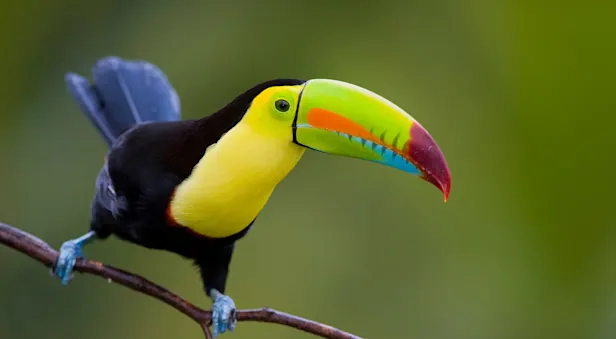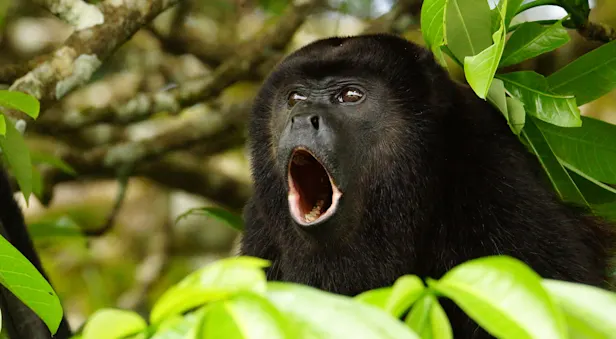
Know Before You Go
Black-Mandibled Toucan Facts | Costa Rica Wildlife Guide
These are the largest toucans in Central America, and they are known for their colorful beaks and plumage. They are important contributors to the rain forest ecosystem because they continually spread fruit seeds. The seeds they consume pass through their digestive systems intact and sprout where they come out the other end.
PHYSICAL CHARACTERISTICS
Males are around 22 inches long and weigh up to 2 pounds.
Plumage is mostly black with maroon on the crown, hindneck, upper back and breast. The throat is deep yellow, bordered by a narrow line of white and red. Shading around the eye is green.
The hollow bill can grow up to 8 inches long.
The bill is slightly translucent, and it is bright yellow on top with dark maroon below.
Although the male is bigger, there is no other difference between the sexes.
RANGE AND HABITAT
The black-mandibled toucan is common throughout Central American and northwestern South American lowland rain forests. They are rarely found above 3,000 feet above sea level. They are canopy-dwelling birds, and they feed and roost in the upper levels of trees. They nest in tree cavities that have decayed or are old woodpecker hollows.
BEHAVIOR AND COMMUNICATION
Cunning and ornery, the black-mandibled toucan will follow the keel-billed toucan to fruit trees and then chase them away. They call to each other in piercing tones, especially in the mornings and evenings. Small flocks, usually consisting of 3 to 12 birds, will travel through the forest together but not farther than about 300 feet at a time.
FEEDING HABITS
Black-mandibled toucans are primarily frugivorous, meaning 90 percent of their diet is fruit. They may catch prey for their young, which need more protein for growth. Some of this protein may come in the form of large insects, lizards, eggs from other birds’ nests, and possibly fly termites that toucans will snatch out of the air.
These toucans forage by maintaining their center of gravity on tree branches and reaching out with their beaks to grab fruit at a distance. They will then toss back their heads and swallow the fruit whole. They tend to hover around particular fruit trees until the fruit is gone, and then they will move on to other trees.
BLACK-MANDIBLED TOUCAN DEVELOPMENT

BREEDING AND REPRODUCTION
Toucans mate in the spring and remain monogamous for the duration of the breeding season. Females lay pure white, elliptical-shaped eggs, usually three to four per clutch. Incubation lasts 16 days. Males and females take turns incubating the eggs, each shift usually lasting about one hour.
CONSERVATION
There is currently no significant threat to black-mandibled toucans, despite ongoing hunting and habitat destruction. Clear-cutting poses a challenge, however, as they are not good flyers, and they must traverse large tracts of open land to find suitable fruit trees. In addition, poachers take toucans for their meat, feathers, and to sell in the illegal pet trade.
































